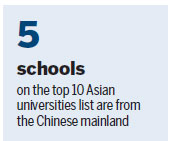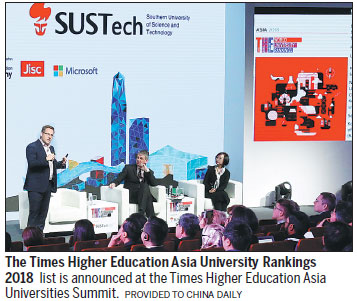Chinese institutions' grades up in regional academic rankings
Chinese mainland universities have benefited from the government's consistent funding programs to improve their performance in world rankings.
On the full list of the Times Higher Education Asia University Rankings 2018, announced on Wednesday, Chinese universities have taken up five spots of the top 10 universities in Asia category.
Of the 350 universities from 25 countries and regions in Asia covered in the rankings, Chinese mainland universities accounted for nearly one-fifth of the total, second only to Japan.
Tsinghua University has moved one place up from last year to become the runner-up in the rankings, just behind the National University of Singapore, with Peking University taking third place.
The University of Hong Kong and The Hong Kong University of Science and Technology rank fourth and fifth, respectively.
The Chinese University of Hong Kong, which was not included in the top 10 in 2017, jumped four spots to occupy seventh place this year.
"The Chinese mainland has seen wonderful success based on the commitment of government funding and investment in universities," said Phil Baty, editorial director of Times Higher Education.

"Two decades of investment and funding have been essential.
"But we have also seen a commitment to reform. We have seen a brilliant campaign to attract Chinese scholars back to China, with their expertise and experience building wonderful laboratories, building great research teams."
Greater international collaboration will take China to the next level, said Baty, adding that if Chinese universities could improve their international collaboration and international links, it would lead to a rise in the quality of their performance.
The results are based on 13 separate performance indicators, covering research excellence, teaching excellence, international activity and industrial relations.
The other four universities in the top 10 list this year are Nanyang Technological University in Singapore which came sixth; the University of Tokyo in Japan, eighth; Seoul National University, ninth; and Korea Advanced Institute of Science and Technology in South Korea, 10th.
The rankings were released in Shenzhen on Wednesday on the sidelines of the Times Higher Education Asia Universities Summit 2018, held at the Southern University of Science and Technology, also known as SUSTech.
Baty praised Shenzhen for its efforts in improving higher-level education. The Chinese southern coastal city is an emerging as a phenomenal global hub for talent and innovation, he said.
"One of the great strengths of Shenzhen, I believe, is its commitment to technological and business innovation, for the universities are very closely integrated with industry.
"We are seeing Shenzhen becoming a knowledge hub. In combination with Hong Kong, where we have six very highly ranked universities, and the wider Pearl River Delta area, Shenzhen is becoming the heart of a really emerging global innovation hub," Baty said.
SUSTech, which is located in Shenzhen, is "a very rapidly emerging powerhouse". Though the university is young, its research output is improving rapidly, he added.
The university is not included in this year's Asia university rankings.
Baty predicted that once the university enters the rankings, it will be placed "at a very high position, maybe in the top 30 of Asia".
With a more internationalized environment, heavy investment from the local region and a high degree of autonomy, SUSTech has great potential and will be a rising star in the rankings, he said.

(China Daily 02/09/2018 page12)














